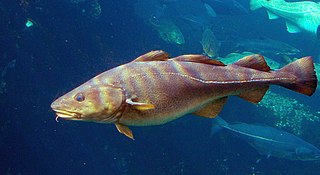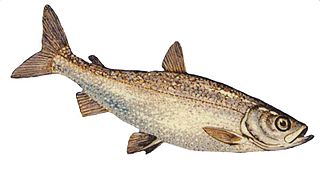
Cod is the common name for the demersal fish genus Gadus, belonging to the family Gadidae. Cod is also used as part of the common name for a number of other fish species, and one species that belongs to genus Gadus is commonly not called cod.

Plovers are members of a widely distributed group of wading birds of family Charadriidae. The term "plover" applies to all the members of the family, though only about half of them include it in their name.

Firs are evergreen coniferous trees belonging to the genus Abies in the family Pinaceae. There are approximately 48–65 extant species, found on mountains throughout much of North and Central America, Eurasia, and North Africa. The genus is most closely related to Keteleeria, a small genus confined to eastern Asia.

Box jellyfish are cnidarian invertebrates distinguished by their box-like body. Some species of box jellyfish produce potent venom delivered by contact with their tentacles. Stings from some species, including Chironex fleckeri, Carukia barnesi, Malo kingi, and a few others, are extremely painful and often fatal to humans.

Kahurangi National Park is a national park in the northwest of the South Island of New Zealand. It is the second largest of the thirteen national parks of New Zealand. It was gazetted in 1996 and covers 5,193 km2 (2,005 sq mi), ranging from the Buller River near Murchison in the south, to the base of Farewell Spit in Golden Bay in the north. The park has no single dominant landform, but includes an unusually wide variety of landscapes, including mountain ranges, rivers, gorges, raised peneplains and karst features such as caves and arches. Many of the landforms within the park are considered to be nationally or internationally significant.

Jeju City is the capital of the Jeju Province in South Korea and the largest city on Jeju Island. The city is served by Jeju International Airport.

Ulleungdo, also spelled Ulreungdo, is a South Korean island 120 kilometres east of the Korean Peninsula in the Sea of Japan. It was formerly known as Dagelet Island or Argonaut Island in Europe. Volcanic in origin, the rocky steep-sided island is the top of a large stratovolcano which rises from the seafloor, reaching a maximum elevation of 984 metres (3,228 ft) at Seonginbong Peak. The island is 9.5 kilometres (6 mi) in length and ten kilometres (6 mi) in width; it has an area of 72.86 km2 (28.13 sq mi). It has a population of 10,426 inhabitants.

The freshwater whitefish are fishes of the subfamily Coregoninae, which contains whitefishes and ciscoes, and is one of three subfamilies in the salmon family Salmonidae. Apart from the subfamily Coregoninae, the family Salmonidae includes the salmon, trout, and char species of the subfamily Salmoninae, and grayling species of the subfamily Thymallinae. Freshwater whitefish are distributed mainly in relatively cool waters throughout the northern parts of the Northern Hemisphere.

The Alaska pollock or walleye pollock is a marine fish species of the cod genus Gadus and family Gadidae.

Polyozellus is a fungal genus in the family Thelephoraceae, a grouping of mushrooms known collectively as the leathery earthfans. Previously considered a monotypic genus, it now contains the Polyozellus multiplex species complex. The genus name is derived from the Greek poly meaning many, and oz, meaning branch. It is commonly known as the blue chanterelle, the clustered blue chanterelle, bluefan, or, in Alaska, the black chanterelle. The distinctive fruit body of this species comprises blue- to purple-colored clusters of vase- or spoon-shaped caps with veiny wrinkles on the undersurface that run down the length of the stem.

Fallow deer is the common name for species of deer in the genus Dama of subfamily Cervinae.

South Korea is a major center of aquaculture production, and the world's third largest producer of farmed algae as of 2020.

Carybdea murrayana, the South African box jellyfish, is a venomous species of cnidarian, in the small family Carybdeidae within the class Cubozoa.
The wildlife of South Korea includes 8,271 plant species, 18,117 animal species and 3,528 species of fungi and others. 30,000 species are known to inhabit South Korea, among an estimated 100,000+ in all.
The Alashanian pipistrelle is a species of bat in the family Vespertilionidae. It is found in China, South Korea, Mongolia, Japan, and Russia.
Carybdea arborifera is a venomous species of cnidarian, in the small family Carybdeidae within the class Cubozoa. The species is rarely seen, but has been observed off the coast of Hawaii.

Carybdea rastonii is a venomous species of cnidarian, in the small family Carybdeidae within the class Cubozoa. They are usually observed near Hawaii and Australia, but have in rare cases been documented off the coasts of California.
Carybdea wayamba is a venomous species of cnidarian, in the small family Carybdeidae within the class Cubozoa. The species is rarely seen, but has been observed off the coast of Sri Lanka.
Carybdea confusa is a venomous species of cnidarian, in the small family Carybdeidae within the class Cubozoa. The species can be found in kelp forests off the coast of California.

Carybdea xaymacana is a venomous species of cnidarian, in the small family Carybdeidae within the class Cubozoa. The species has been documented off the coast of Mexico and Australia. To distinguish this species from other cubozoans along the Mexican coasts, one can note its four pedalia, each containing a single tentacle, and its heart-shaped rhopaliar niche ostium.
















